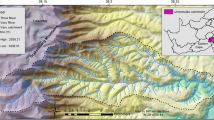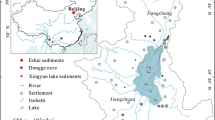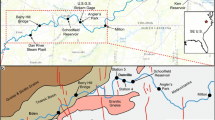Abstract
Purpose
Almost 50 % of wetland types in South Africa are regarded as critically endangered. Erosion is extensively present in many wetlands and has been primarily attributed to human activities. However, many researchers have suggested that the erosion of some wetland types is a long-term naturally recurring process and may be preceded by fire events. Wetland sediments are highly affected by processes of dissolution diagenesis, so that very little evidence of catchment processes would be expected to be preserved by their magnetic signatures. However, previously published research has shown that the magnetic signatures of fire can be preserved in some wetland and lake sediments.
Materials and methods
The mineral magnetic properties of sediment cores were examined to attempt to identify the signatures of historical fires in the Kromrivier wetland, a palmiet dominated wetland in the Eastern Cape of South Africa. This wetland has recently been burnt by a large fire event in 2011. The burning of catchment soils and sediments in controlled laboratory experiments was used to replicate the processes of magnetic enhancement taking place in the wetland.
Results and discussion
The majority of wetland sediment was very weakly magnetic due to processes of dissolution diagenesis. However, deposits of extremely magnetic sediment were found within the wetland. These deposits were attributed to the high temperature combustion of the wetland magnetically enhancing the fine-grained (<25 μm) sediment trapped in vegetation. These magnetically enhanced sediments were then selectively transported and concentrated in narrow channels flowing through the wetland. The rapid burial of enhanced grains (in the super paramagnetic–single domain size range) below the permanent water table is the most likely explanation for the good preservation of the fire signature.
Conclusions
A history of fire events was preserved within the wetland sediments, which showed that combustion has taken place throughout its history. A complex process of sediment (particle size specific) magnetic enhancement, transport and storage results in the preservation of magnetic grains despite a highly reducing wetland environment.










Similar content being viewed by others
References
Anderson NJ, Rippey B (1988) Diagenesis of magnetic minerals in the recent sediments of a eutrophic lake. Limnol Oceanogr 33:1476–1492
Blake WH, Wallbrink PJ, Doerr SH, Shakesby RA, Humphreys GS (2006a) Magnetic enhancement in wildfire-affected soil and its potential for sediment-source ascription. Earth Surf Process Landf 31(2):249–264
Blake WH, Wallbrink PJ, Doerr SH, Shakesby RA, Humphreys GS, English P, Wilkinson S (2006b) Using geochemical stratigraphy to indicate post-fire sediment and nutrient fluxes into a water supply reservoir, Sydney, Australia. In: Rowan JS, Duck RW, Werritty A (eds) Sediment dynamics and the hydromorphology of fluvial systems, proceedings of an international conference at Dundee, Scotland, IAHS Publication 306. IAHS Press, Wallingford, pp. 363–370
Boucher C, Withers M (2004) Palmiet. Prionium serratum, a cape river plant. Veld Flora 90:26–28
Clement BM, Javier J, Sah JP, Ross MS (2011) The effects of wildfires on the magnetic properties of soils in the Everglades. Earth Surf Process Landf 36(4):460–466
Dearing J (1999) Magnetic susceptibility. In: Walden J, Oldfield F, Smith J (eds) Environmental Magnetism a Practical Guide, Technical Guide: No 6. Quaternary Research Association, London, pp. 35–62
Dearing JA, Dann RJL, Hay K, Lees JA, Loveland PJ, Maher BA, O’Grady K (1996) Frequency-dependent susceptibility measurements of environmental materials. Geophys J Int 124(1):228–240. doi:10.1111/j.1365-246X.1996.tb06366.x
Foster IDL, Lees JA, Owens PN, Walling DE (1998) Mineral magnetic characterization of sediment sources from an analysis of lake and floodplain sediments in the catchments of the Old Mill reservoir and Slapton Ley, South Devon, UK. Earth Surf Process Landf 23(8):685–703
Foster IDL, Oldfield F, Flower RJ, Keatings K (2008) Mineral magnetic signatures in a long core from Lake Qarun, Middle Egypt. J Paleolimnol 40(3):835–849
Gedye SJ, Jones RT, Tinner W, Ammann B, Oldfield F (2000) The use of mineral magnetism in the reconstruction of fire history: a case study from Lago di Origlio, Swiss Alps. Palaeogeogr Palaeoclimatol Palaeoecol 164:101–110
Gray AB, Pasternack GB, Watson EB (2010) Hydrogen peroxide treatment effects on the particle size distribution of alluvial and marsh sediments. The Holocene 20(2):293–301
Grimshaw HM, Allen SE, Parkinson JA (1989) Nutrient elements. In: Allen SE (ed) Chemical analysis of ecological materials. Blackwell, Oxford, p. 368
Hanesch M, Petersen N (1999) Magnetic properties of a recent parabrown–earth from Southern Germany. Earth Planet Sci Lett 169:85–97
Hanesch M, Stanjek H, Petersen N (2006) Thermomagnetic measurements of soil iron minerals; the role of organic carbon. Geophys J Int 165:53–61
Hogg AG, Hua Q, Blackwell PG, Niu M, Buck CE, Guilderson TP, Heaton TJ, Palmer JG, Reimer PJ, Reimer RW, Turney CSM, Zimmerman SRH (2013) SHCal13 Southern Hemisphere calibration, 0–50,000 years cal BP. Radiocarbon 55(4):1889–1903. doi:10.2458/azu_js_rc.55.16783
Jelinowska A, Tucholka P, Gasse F, Fontes JC (1995) Mineral magnetic record of environment in late Pleistocene and Holocene sediments, Lake Manas, Xinjiang, China. Geophys Res Lett 22:953–956
Lees JA (1997) Mineral magnetic properties of mixtures of environmental and synthetic materials: linear additivity and interaction effects. Geophys J Int 131(2):335–346
Maher BA (1986) Characterization of soil by mineral magnetic measurements. Phys Earth Planet Inter 42:76–92
Maher BA (1998) Magnetic properties of modern soils and Quaternary loessic paleosols: paleoclimatic implications. Palaeogeogr Palaeocl 137:25–54
Mighall TM, Foster IDL, Crew P, Chapman AS, Finn A (2009) Using mineral magnetism to characterise ironworking and to detect its evidence in peat bogs. J Archaeol Sci 36:130–139
Nel JL, Driver A, Strydom WF, Maherry A, Petersen C, Hill L, Roux DJ, Nienaber S, van Deventer H, Swartz E, Smith-Adao LB (2011) Atlas of freshwater ecosystem priority areas in South Africa: maps to support sustainable development of water resources. WRC Report No. TT 500/11, Water Research Commission: South Africa
Oldfield F, Crowher J (2007) Establishing fire incidence in temperate soils using magnetic measurements. Palaeogeogr Palaeocl 249:362–369
Oldfield F, Thompson R, Dickson DPE (1981) Artificial enhancement of stream bedload: a hydrological application of superpramagnetism. Phys Earth Planet Inter 26:107–124
Oldfield F, Hao Q, Bloemendal J, Gibbs-Eggar Z, Patil S, Guo Z (2009) Links between bulk sediment particle size and magnetic grain-size: general observations and implications for Chinese loess studies. Sedimentology 56(7):2091–2106
Opdyke ND, Channell JET (1996) Magnetic stratigraphy. Academic Press, San Diego
Pulley S, Foster I, Rowntree K (2015a) Conservatism of mineral magnetic signatures in farm dam sediments in the South African Karoo: the potential effects of particle size and post-depositional diagenesis. J Soils Sediments 15(12):2387–2397
Pulley S, Foster I, Antunes P (2015b) The application of sediment fingerprinting to floodplain and lake sediment cores: assumptions and uncertainties evaluated through case studies in the Nene Basin, UK. J Soils Sediments 15(10):2132–2154
Rebelo AJ (2012) An ecological and hydrological evaluation of the effects of restoration on ecosystem services in the Kromme River System, South Africa (Doctoral dissertation, Stellenbosch: Stellenbosch University)
Reynolds RL, Rosenbaum JG, Metre PV, Tuttle M, Callender E, Goldin A (1999) Greigite (Fe3O4) as an indicator of drought—the 1912–1994 sediment magnetic record from White Rock Lake, Dallas, Texas, USA. J Paleolimnol 21:193–206
Roberts AP (1995) Magnetic properties of sedimentary greigite (Fe3S4). Earth Planet Sci Lett 134(3–4):227–236
Rummery TA (1983) The use of magnetic measurements in interpreting the fire histories of lake drainage basins. Hydrobiologia 103(1):53–58
Salvia M, Ceballos D, Grings F, Karszenbaum H, Kandus P (2012) Post-fire effects in wetland environments: landscape assessment of plant coverage and soil recovery in the Paraná river delta marshes, Argentina. Fire Ecol 8(2):17–37
Sieben EJJ (2012) Plant functional composition and ecosystem properties: the case of peatlands in South Africa. Plant Ecol 213:809–820
Simms JE, Lobred AR (2011) Application of magnetic susceptibility for wetlands delineation. J Environ Eng Geophys 16(3):105–114
Smith J (1999) An introduction to the properties of natural materials. In: Walden J, Oldfield F, Smith J (eds) Environmental magnetism, a practical guide. Technical Guide No. 6. Quaternary Research Association, London, pp. 5–25
Talma AS, Vogel JC (1993) A simplified approach to calibrating C14 dates. Radiocarbon 35(2):317–322
Thompson R (1986) Environmental magnetism. In: Thompson R, Oldfield F (eds) Environmental magnetism. Allen and Unwin (Publishers) Ltd, London
Tuttle ML, Goldhaber MB (1993) Sedimentary sulfur geochemistry of the Paleogene Green River Formation, western USA: implications for interpreting depositional and diagenetic process in saline alkaline lakes. Geochim Cosmochim Acta 57:3023–3039
Tuttle ML, Rice CA, Goldhaber MB (1990) Geochemistry of organic and inorganic sulfur in ancient and modern lacustrine environments. In: Orr WL, White CM (eds) Geochemistry of Sulfur in Fossil Fuels. American Chemical Society Symposium Series vol 429. p 114–148
Van Oorschot HM (2002) Chemical distinction between lithogenic and pedogenic iron oxides in environmental magnetism. PhD Thesis; Universiteit Utrecht
Vepraskas MJ (1992) Redoximorphic features for identifying Aquatic conditions. North Carolina Agricultural research service Technical. Bulletin 301; North Carolina, USA
Verosub KL, Roberts AP (1995) Environmental magnetism: Past, present, and future. J Geophys Res 100(B2):2175–2192
Walden J (1999) Remanence measurements. In: Walden J, Oldfield F, Smith JP (eds) Environmental magnetism a practical guide, technical guide no 6. Quaternary Research Association, London, pp. 63–88
Wang G, Oldfield F, Xia D, Chen F, Liu X, Zhang W (2012) Magnetic properties and correlation with heavy metals in urban street dust: a case study from the city of Lanzhou, China. Atmos Environ 46:289–298
Yang T, Liu Q, Li H, Zeng Q, Chan L (2010) Anthropogenic magnetic particles and heavy metals in the road dust: magnetic identification and its implications. Atmos Environ 44(9):1175–1185
Zwanka WP, Hurt GW, Graetz DA, Graham WD, Clark MW (2007) Using magnetic susceptibility to delineate hydric soils in southeastern coastal plain soils. Soil Survey Horizons 48:32–38
Acknowledgments
Much of the work on this project was funded through a postdoctoral scholarship (to Simon Pulley) provided by Rhodes University. The field work was funded through a grant provided to Prof. Ellery by the National Research Foundation, South Africa. We would also like to thank Prof. Barbara Maher (Lancaster University) and Prof. Frank Oldfield (University of Liverpool) for their helpful suggestions regarding the interpretation of the magnetic signatures and Mr. Dennis Ferreira for access to his land and knowledge about the fire history of the wetland.
Author information
Authors and Affiliations
Corresponding author
Additional information
Responsible editor: Rajith Mukundan
Rights and permissions
About this article
Cite this article
Pulley, S., Lagesse, J. & Ellery, W. The mineral magnetic signatures of fire in the Kromrivier wetland, South Africa. J Soils Sediments 17, 1170–1181 (2017). https://doi.org/10.1007/s11368-016-1577-0
Received:
Accepted:
Published:
Issue Date:
DOI: https://doi.org/10.1007/s11368-016-1577-0




